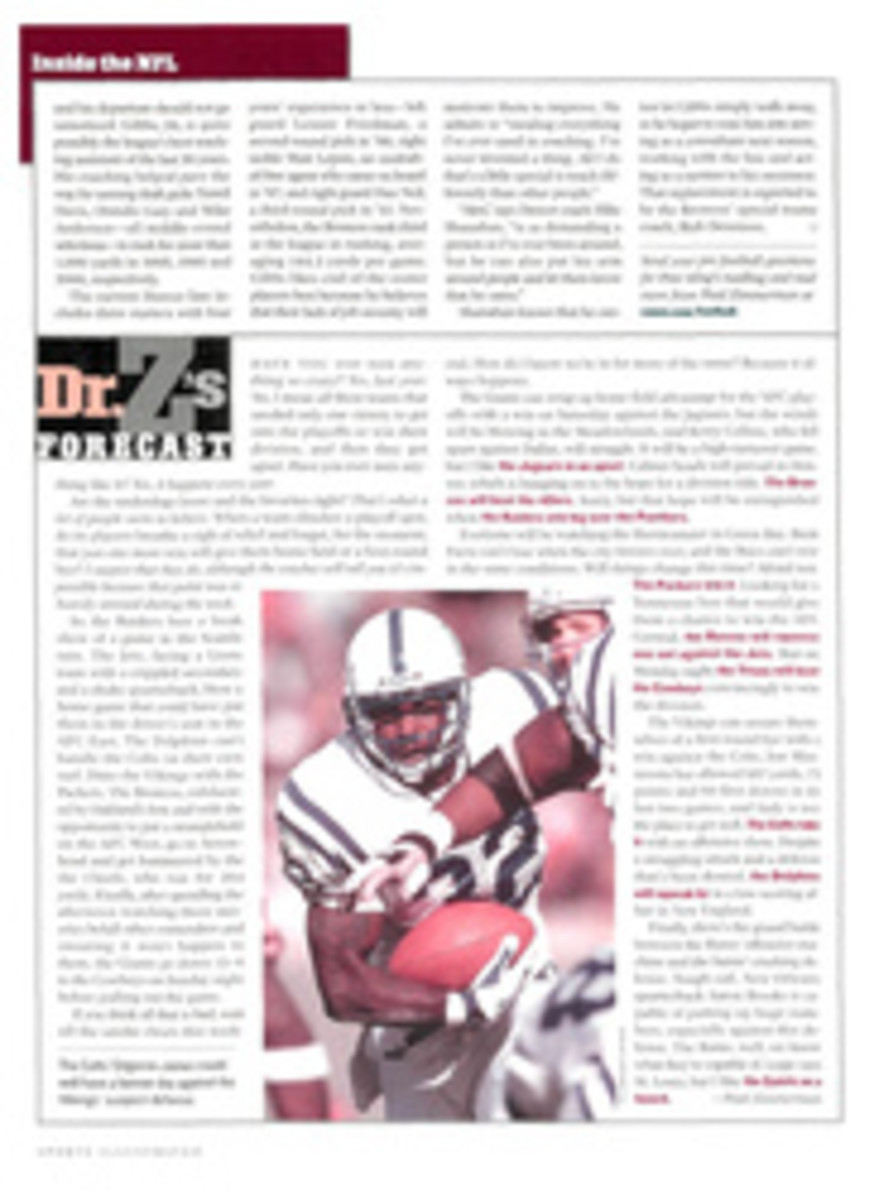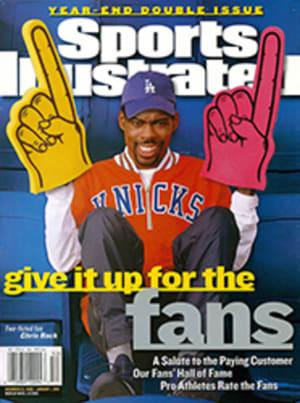
Seminole Fact Florida State's offense will be too quick for Oklahoma's staunch defense
Let's not kid ourselves. If Oklahoma doesn't contain quarterback
Chris Weinke and the rest of the Florida State passing attack, it
won't matter whether Sooners quarterback Josh Heupel has
recovered from the inflamed bursa in his left elbow, which
hampered his passing in the last month of the season. "Oklahoma
hasn't played a team that runs and passes as well as Florida
State," says North Carolina State coach Chuck Amato, a former
Seminoles assistant whose Wolfpack lost 58-14 to Florida State.
On the other hand, if anyone knows how to slow down the
Seminoles, it's Oklahoma coach Bob Stoops, who as defensive
coordinator at Florida from 1996 to '98 went 2-2 against Florida
State (the teams played twice in '96). In his second season at
Oklahoma, Stoops has guided the Sooners to the Top 10 in nearly
every significant defensive category, including second in
pass-efficiency defense. Coaches in the Big 12 as well as
Seminoles offensive coordinator Mark Richt echo one another in
describing Oklahoma's defense: The Sooners don't make mistakes.
They tackle well. They disguise what they're doing better than
most teams.
"One thing about Coach Stoops," Richt says, "he's not afraid to
play certain coverages on any down and distance. So many coaches
are predictable. Coach Stoops isn't. On third-and-long situations
against Kansas State in the Big 12 title game, he played four
coverages. In such a situation the Sooners will show a two-deep
umbrella, and then they'll do all kinds of things. Either safety
will come up, or a corner will blitz, or they'll play two-deep,
three-deep."
Like the best baseball defenses, Oklahoma is strong up the
middle, especially at linebacker, where Rocky Calmus and Torrance
Marshall finished one-two on the team in tackles. At 6'1", 300
pounds, left tackle Ryan Fisher is built like a Hummer and is
about as easy to push. "One play against Kansas State, the center
hits him and the guard double-teams him," Florida State center
Jarad Moon says of Fisher. "They're in pretty good position,
shoulder-to-shoulder. Fisher splits right through them and
tackles the running back a yard deep in the backfield. You have
to be quick to get in that seam. Once you're in there, you have
to be strong [to get through it]."
Though Richt compares the Sooners' defensive scheme to Florida's,
Oklahoma co-defensive coordinator Mike Stoops (Bob's younger
brother) likens his team's defensive philosophy to that of the
Seminoles'. "We're going to challenge you on early downs and show
you a lot of looks on the late downs," he says. "We're going to
make you throw it by having everybody stopping the run."
Miami used a similar plan in its 27-24 defeat of Florida State on
Oct. 7. Greg Schiano, who was the Hurricanes' defensive
coordinator before leaving in early December to become the coach
at Rutgers, says he picked his poison. "If they can run and pass,
you've got a problem," he says of the Seminoles. "You have to
turn it into a one-dimensional game. We forced them to throw. We
stopped the run, and we won third down."
Weinke, who played against Miami with a sprained left ankle,
threw for 496 yards and three touchdowns in that game. However,
Florida State rushed for only 69 yards on 27 carries. Tailback
Travis Minor finished with 36 yards on 12 carries. The Seminoles
attempted six runs on third down and gained a total of seven
yards.
Miami could afford to focus on the run because it has one of the
best secondaries in the nation. The Sooners have another, thanks
to safeties J.T. Thatcher and Roy Williams. Though Thatcher, the
free safety, has received more publicity for his eight
interceptions, the third most in the nation, it's strong safety
Williams whom opposing coaches bring up without prompting. "A
linebacker-type hitter," Richt says of Williams, a 6-foot,
221-pound sophomore. Williams and Thatcher both play closer to
the line of scrimmage than is typical for either position. "Even
though an interception is very good," says Williams, who has two
this season, one of which he returned 35 yards for a touchdown,
"I'd rather have a tackle. Tackling is an art."
Florida State senior wideout Marvin (Snoop) Minnis spoke
mysteriously in mid-December of having seen "vulnerabilities" in
the Sooners' defense but declined to be specific. However, when
asked about Williams and Thatcher crowding the line of scrimmage,
he started giggling. "That's part of the vulnerabilities," he
said. "When a team plays its safety up, it leaves the cornerback
on an island. That's an advantage for the offense."
Before this season the 6'1", 185-pound Minnis had made only 52
catches in his career, largely because Weinke had other
outstanding receivers, including Peter Warrick. Minnis seethed
all summer over being questioned about whether he could replace
Warrick. He has channeled that anger into his play, finishing
with 1,340 receiving yards, the second-highest total ever at
Florida State, and 11 touchdowns on 63 catches. "I remember
thinking after the third or fourth game, Has he always been this
good?" Richt says.
"I'm kicking myself in the butt a lot of times when I watch
film," says Weinke. "I watch him get open and wonder, Why didn't
I see that? Against Miami there were a couple of situations where
I could have gone to him and gotten touchdowns."
Though Minnis became a first-team All-America, his greatest honor
came from receivers coach Jeff Bowden (son of head coach Bobby).
Midway through the season Bowden instituted the Snoop Rule. "If
Snoop isn't tired, he ain't coming out," Richt says. On a team
that prides itself on frequent substitutions to wear down an
opponent, that's high praise.
Oklahoma has an advantage in the kicking game with Tim Duncan,
who made 11 of 15 field goals inside 40 yards. Though Miami may
have stopped Florida State on the ground, the real reason the
Seminoles lost was that the coaches had so little confidence in
their kickers. Twice in the first quarter Florida State drove
into the Hurricanes' red zone and refused to try a field goal.
Both times the Seminoles failed to convert on fourth down. One
could argue that Matt Munyon validated that lack of confidence by
missing two field goal attempts in the second half, including a
49-yarder as time expired. "Our thinking was wrong," says Richt.
"We may try four field goals [against Oklahoma] and miss all
four, but we're going to try them." The good news for Florida
State is that freshman Brett Cimorelli, one of the two kickers
who took over for Munyon after the Miami game, proved to be more
reliable, making six of nine field goal attempts in the
Seminoles' final four games.
The Sooners are the only undefeated team in the nation. Their
bodies are resilient--no starter has missed significant time
because of injury--and so are their minds. When they had to come
back against Nebraska and Texas A&M, they did. When they had to
hold off Kansas State, twice, they did. Those strengths should
help overcome the willies that will attack them in the Orange
Bowl.
Florida State, however, has eight starters and 34 lettermen
making their third consecutive trip to a national championship
game. The Seminoles are nearly a two-touchdown favorite, a
testament to the oddsmakers' faith in the public's willingness
to support a familiar face. The guess here is that it will be
closer than that--say, Florida State 31, Oklahoma 24.
--Ivan Maisel
COLOR PHOTO: ANDY LYONS/ALLSPORT Atrews Bell is one of nine Seminoles who caught at least 12 passes this year.
"If Florida State can run and pass, you've got a problem," says
Schiano. "You have to turn it into a one-dimensional game."

